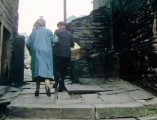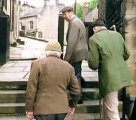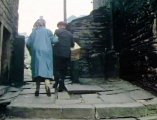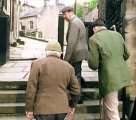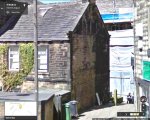You are using an out of date browser. It may not display this or other websites correctly.
You should upgrade or use an alternative browser.
You should upgrade or use an alternative browser.
Cafe,the First time I have spotted this
- Thread starter maltrab
- Start date
brendalovescompo
Dedicated Member
I suppose as the series was gaining popularity, Holmfirth thought they should work on the flagstones. I have noticed in other early shows that the alleys were rough in front of Compo and Nora's house. The landscaping also got done up as the years went on also.
The whole of Holmfirth was spruced over time especialy when the clean air act came in to being,until then everywhere in the north was sooty and dark but full of character now it looks to clean.The flagstone was something that probably all the locals knew it was there and did not bother about it you would not have received compensation in those days if you fell over it! Has anyone noticed how the lane alongside the river at Nora,s became smarter over the years the grass was cut and a gate appeared someone was spending their brass.
Maybe Compo got his nickname from once tripping over the flagstones and claiming off the council???:wink:The whole of Holmfirth was spruced over time especialy when the clean air act came in to being,until then everywhere in the north was sooty and dark but full of character now it looks to clean.The flagstone was something that probably all the locals knew it was there and did not bother about it you would not have received compensation in those days if you fell over it! Has anyone noticed how the lane alongside the river at Nora,s became smarter over the years the grass was cut and a gate appeared someone was spending their brass.
Marianna
Dedicated Member
Maybe Compo got his nickname from once tripping over the flagstones and claiming off the council???:wink:
Possibly, but I think it was more likely to have been worker's comp.
Marianna
Marianna
Dedicated Member
The whole of Holmfirth was spruced over time especialy when the clean air act came in to being,until then everywhere in the north was sooty and dark but full of character now it looks to clean.The flagstone was something that probably all the locals knew it was there and did not bother about it you would not have received compensation in those days if you fell over it! Has anyone noticed how the lane alongside the river at Nora,s became smarter over the years the grass was cut and a gate appeared someone was spending their brass.
There's fairly expensive new housing on some of the former mill sites in and around Holmfirth, and judging from the real estate sale ads some of the over-and-under dwellings in town have been gussied up nearly beyond recognition. That would bolster the tax base and enable the council to improve the infrastructure, for instance the state of the flagstone paving. With the mills gone and no industry to replace them, the town must have become another dormitory community for Bradford and Leeds to support that much up-market housing. There's certainly income to be had from tourism, but not enough to support that many apparently prosperous households.
I'm sure the households in the refurbished buildings are much more prosperous than the ones I saw in the census records I've looked at (1851 to see households the year before the Bilberry Reservoir flood, and 1911 looking for the shop-holder at Sid's site). The 1911 census listed a lot of two or three room dwellings housing families of four or five, often plus a lodger, with everyone, even youngsters barely in their teens, working in the mills or elsewhere around the town. Some of those very crowded households were underdwellings in Scarfold, the lane along the river just beyond Nora's house.
Households were even more crowded in 1851 than in 1911, with children as young as 10 working in the mills or running errands for shopkeepers. Very few of those working children were also listed as part-time scholars. Living and working in Holmfirth while the mills were operating at full capacity must have been at least as tough as it was to live there in the 1970s with all the unemployment from the mills having fewer orders or having permanently shut down.
Marianna
me2
Dedicated Member
This screen shot with the lean-to and crooked flagstones was from "Serenade for Tight Jeans and Metal Detector" which was aired February 8, 1982.
In "The Arts of Concealment," which was aired on March 6, 1983 just one year later, the lean-to was gone and the flagstones repaired.
So "Serenade for Tight Jeans and Metal Detector" may have the only shot of the lean-to.
In "The Arts of Concealment," which was aired on March 6, 1983 just one year later, the lean-to was gone and the flagstones repaired.
So "Serenade for Tight Jeans and Metal Detector" may have the only shot of the lean-to.
Sarkus
Dedicated Member
This screen shot with the lean-to and crooked flagstones was from "Serenade for Tight Jeans and Metal Detector" which was aired February 8, 1982.
In "The Arts of Concealment," which was aired on March 6, 1983 just one year later, the lean-to was gone and the flagstones repaired.
So "Serenade for Tight Jeans and Metal Detector" may have the only shot of the lean-to.
It would be interesting to see if there are earlier shots of that area (from earlier episodes) without the lean-to. That would indicate it was a relatively temporary structure in that space for some reason.
me2
Dedicated Member
There are not many shots of that area, but I just remembered Compo comes to the café from that direction in "The Man from Oswestry." I checked it out and the lean-to is there as well as the wonky flagstones and uneven steps. That was aired October 27, 1976. Since it was still there during the 1982 filming 6 years later, it was probably not just a temporary structure.
I don't remember any shots of the area during the Blamire years but I'll keep my eyes open.
I don't remember any shots of the area during the Blamire years but I'll keep my eyes open.
Marianna
Dedicated Member
I don't remember any shots of the area during the Blamire years but I'll keep my eyes open.
Pâté and Chips, 4 minutes and 35 seconds into the episode. The lean-to looks as though it might have been built of stone.
Marianna
me2
Dedicated Member
Pâté and Chips, 4 minutes and 35 seconds into the episode. The lean-to looks as though it might have been built of stone.
Marianna
That episode aired in November of 1973, so it was their for about 9 years than we know of. It is built of the same bricks as the building so it appears it may have been original.
me2
Dedicated Member
We can only see two sides of the lean-to from the shots in the script. There are no doors on those two sides. If it was a coal bin, the door would have to be on the other side, which is the street side (which would make sense for a coal bin). However, if there is no door on that side either, than it would have to be just storage or space accessed from the inside.If it was made of brick maybe it was an old coal bin or access of some kind for the building? Not too familiar with how that worked as burning coal directly is something I have zero experience with. Here its pretty much electric heat, wood, gas, and some oil.
The only episode I can think of where they filmed on that side of the building, was "Mending Stuart's Leg." I watched that again and don't see a view of the lean-to. I'll try to keep watch for any other early episode that filmed on that side of the building.
Last edited:
Dennisbn514
Dedicated Member
To add to the Cafe Lean-to mystery
Attached is a Google Maps street view of the rear of the Café as it looks today (or at least as it was when the picture was taken). This view is looking at the church and Café courtyard where you can see some people sitting.
There appears to be an outline of another structure that may have been attached to the Cafe building at some point in its past. When this other structure was eventually removed, the exposed bricks can be seen as relatively clean and fresh looking. The original right half bricks look weathered and black as if they had never been covered. It doesn't look like the color change is caused by sunlight because the shadows are wrong.
And if they were trying to clean it up, would they only do half of the rear face?
Just an observation.
Attached is a Google Maps street view of the rear of the Café as it looks today (or at least as it was when the picture was taken). This view is looking at the church and Café courtyard where you can see some people sitting.
There appears to be an outline of another structure that may have been attached to the Cafe building at some point in its past. When this other structure was eventually removed, the exposed bricks can be seen as relatively clean and fresh looking. The original right half bricks look weathered and black as if they had never been covered. It doesn't look like the color change is caused by sunlight because the shadows are wrong.
And if they were trying to clean it up, would they only do half of the rear face?
Just an observation.
Attachments
Last edited:
Marianna
Dedicated Member
It looks as though the 'lean-to' must have been two stories high. So now I wonder when the height was reduced to one story, and if whatever was in it was for the use of the business in the cafe building or for the people in the building across the way. Access would have been handier for the latter.
I wish I were acquainted with someone who has lived in Holmfirth all of his or her life and who is old enough to clearly recall the '70s and earlier. He or she would probably know the lean-to's purpose and when it was demolished. Andrew Bray, the greengrocer, might remember. He was a youngster when the Summer Wine cast and crew arrived to film the pilot, but old enough that he and Bill Owen became friends.
I'll take another look at the video about the '44 flood. It includes a lot of Harry Bray's photos taken during and immediately after that flood, and might include a photo looking toward the church from South Lane. If there is one, it would show whether or not there was a door on that side of the lean-to. BTW Harry Bray was the grandfather of Helen Bray who has the photography studio a little way up Dunford Road from the intersection with South Lane, a few yards from the passageway where the lean-to was.
Marianna
I wish I were acquainted with someone who has lived in Holmfirth all of his or her life and who is old enough to clearly recall the '70s and earlier. He or she would probably know the lean-to's purpose and when it was demolished. Andrew Bray, the greengrocer, might remember. He was a youngster when the Summer Wine cast and crew arrived to film the pilot, but old enough that he and Bill Owen became friends.
I'll take another look at the video about the '44 flood. It includes a lot of Harry Bray's photos taken during and immediately after that flood, and might include a photo looking toward the church from South Lane. If there is one, it would show whether or not there was a door on that side of the lean-to. BTW Harry Bray was the grandfather of Helen Bray who has the photography studio a little way up Dunford Road from the intersection with South Lane, a few yards from the passageway where the lean-to was.
Marianna
cciaffone
Dedicated Member
I wish I were acquainted with someone who has lived in Holmfirth all of his or her life
You could try the couple who run the Springfield Guest House on
Huddersfield road across from the co-op. They are Ann and Bernard
Brook and can be reached at:
brook_bernard65@btinternet.com
They might know/remember. They brought up a family there.
Marianna
Dedicated Member
I revisited the Mike Wade film, A Wall of Water, particularly looking for any photos showing the lean-to on the side of the cafe building from the point of view of South Lane to see if it was one or two stories high and if there was a door on that side, but since none of the people he interviewed lived in the buildings facing that passageway, he didn't include a photo of that spot. Maybe Harry Bray didn't photograph it, either, as that area just barely missed being flooded.
Marianna
Marianna



